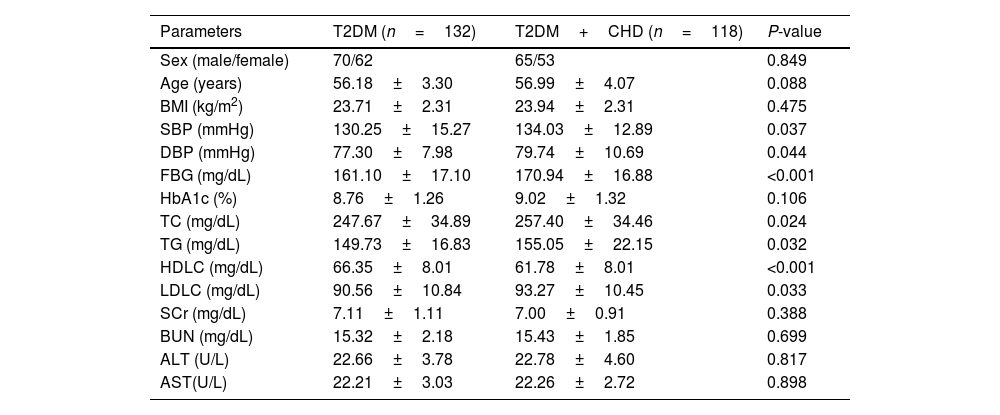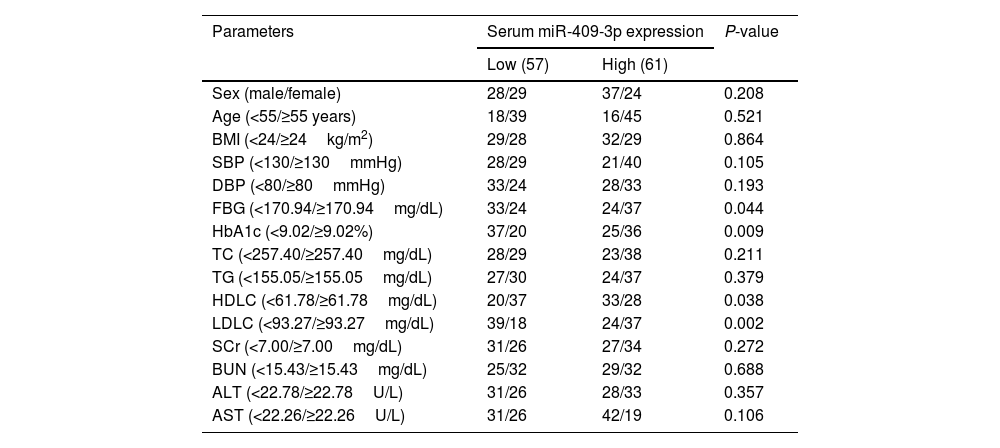To investigate the serum levels of miR-409-3p in patients with type 2 diabetes mellitus (T2DM) complicated with coronary heart disease (CHD) and its effect on high glucose (HG)-induced myocardial cell injury.
MethodsA total of 250 patients with T2DM admitted to our hospital from April 2020 through April 2022 were enrolled as the study subjects, and then grouped into T2DM+CHD (group #1) and T2DM (group #2). Real-time quantitative PCR (RT-qPCR) was used to measure the levels of serum miR-409-3p. The clinical performance of miR-409-3p was evaluated. The human cardiomyocyte AC16 cells were cultured in vitro and treated with HG. MTT assay and flow cytometry were performed to detect cell viability and apoptosis, respectively. Bioinformatic analyses were performed to explore the potential mechanism of miR-409-3p in T2DM complicated with CHD.
ResultsThe expression level of miR-409-3p was increased in the T2DM+CHD group and had a relative high diagnostic value for distinguishing patients with T2DM+CHD from patients with T2DM alone. Correlation analysis showed that serum miR-409-3p was positively associated with the Gensini score and adverse cardiovascular events; miR-409-3p knockdown alleviated HG-induced AC16 cell damage and reduced cell apoptosis. CREB1, BCL2, and SMAD2 were the top 3 hub genes of miR-409-3p.
ConclusionSerum miR-409-3p may serve as a potential diagnostic and prognostic biomarker for predicting T2DM complicated with CHD and forecast adverse events. Targeting miR-409-3p may be a novel therapeutic strategy to intervene in the development of T2DM+CHD.
Investigar los niveles séricos de miR-409-3p en pacientes con diabetes mellitus tipo 2 (DMT2) complicada con cardiopatía coronaria (CC) y su efecto sobre la lesión celular miocárdica inducida por glucosa alta (HG).
MétodosUn total de 250 pacientes con DMT2 admitidos en nuestro hospital desde abril de 2020 hasta abril de 2022 se inscribieron como los sujetos del estudio, que se agrupan en DMT2 combinado con el grupo CC y el grupo DMT2. Se aplicó la PCR cuantitativa en tiempo real (RT-qPCR) para medir los niveles de miR-409-3p en suero. Se evaluó el rendimiento clínico de miR-409-3p. Se cultivaron in vitro células de cardiomiocitos humanos AC16 y se trataron con HG. Se realizaron ensayos MTT y citometría de flujo para detectar la viabilidad celular y la apoptosis, respectivamente. Se realizaron análisis bioinformáticos para explorar el mecanismo potencial de miR-409-3p en la DMT2 complicada con cardiopatía coronaria.
ResultadosEl nivel de expresión de miR-409-3p estaba aumentado en el grupo de DMT2+CC y tenía un valor diagnóstico relativamente alto para distinguir a los pacientes con DMT2 y CC de los pacientes con DMT2 sola. El análisis de correlación mostró que miR-409-3p en suero se asociaba positivamente con la puntuación de Gensini y los eventos cardiovasculares adversos. La eliminación de miR-409-3p alivió el daño celular AC16 inducido por HG y redujo la apoptosis celular. CREB1, BCL2 y SMAD2 fueron los 3 genes principales de miR-409-3p.
ConclusionesEl miR-409-3p sérico puede servir como posible biomarcador diagnóstico y pronóstico para predecir la DMT2 complicada con cardiopatía coronaria y pronosticar acontecimientos adversos. Dirigirse a miR-409-3p puede ser una estrategia terapéutica novedosa para intervenir en el desarrollo de la cardiopatía coronaria combinada con la DMT2.













